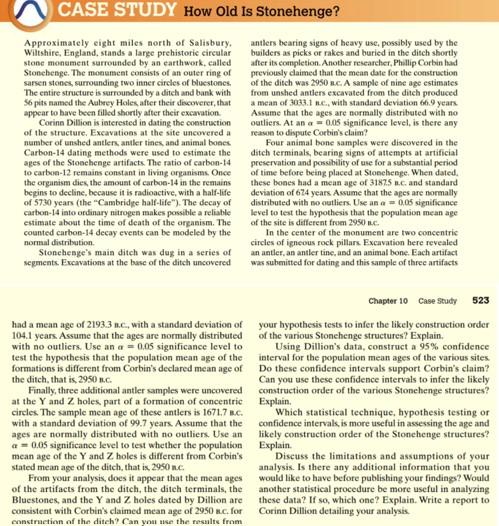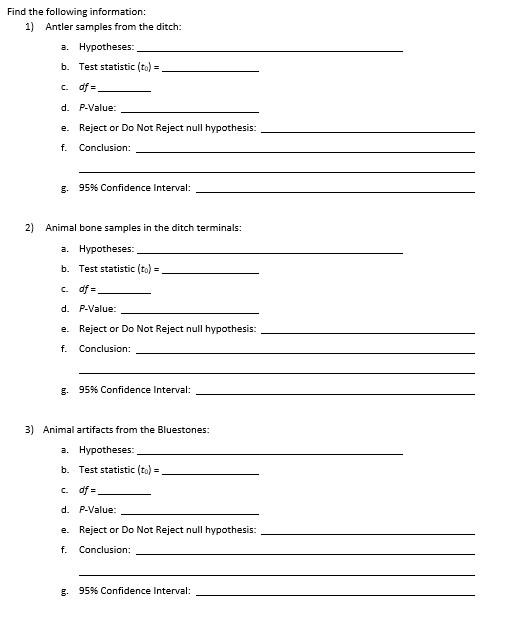This problem has been solved!
You'll get a detailed solution from a subject matter expert that helps you learn core concepts.
See AnswerSee Answer done loadingQuestion: CASE STUDY How Old Is Stonehenge? Approximately eight miles north of Salisbury, Wiltshire, England, stands a large prehistoric circular stone monument surrounded by an earthwork, called Stonehenge. The monument consists of an outer ring of sarsen stones, surrounding two inner circles of bluestones. The entire structure is surrounded by a ditch and bank with
- There are 3 steps to solve this one.Who are the experts?Experts have been vetted by Chegg as specialists in this subject.Expert-verifiedStep 1View the full answer
1.Antler samples from the ditch:
a. Hypotheses:
H0: μ = 2950 (Corbin's claimed mean age)
Ha: μ ≠ 2950 (...Step 2 UnlockStep 3UnlockAnswerUnlock
UnlockStep 3UnlockAnswerUnlock
Transcribed image text:
CASE STUDY How Old Is Stonehenge? Approximately eight miles north of Salisbury, Wiltshire, England, stands a large prehistoric circular stone monument surrounded by an earthwork, called Stonehenge. The monument consists of an outer ring of sarsen stones, surrounding two inner circles of bluestones. The entire structure is surrounded by a ditch and bank with 56 pits named the Aubrey Holes after their discoverer, that appear to have been filled shortly after their excavation Corinn Dillion is interested in dating the construction of the structure. Excavations at the site uncovered a number of unshed antlers, antler tines, and animal bones Carbon-14 dating methods were used to estimate the ages of the Stonehenge artifacts. The ratio of carbon-14 to carbon-12 remains constant in living organisms. Once the organism dies, the amount of carbon-14 in the remains begins to decline, because it is radioactive, with a half-life of 5730 years (the "Cambridge half-life"). The decay of carbon-14 into ordinary nitrogen makes possible a reliable estimate about the time of death of the organism. The counted carbon-14 decay events can be modeled by the normal distribution. Stonehenge's main ditch was dug in a series of segments. Excavations at the base of the ditch uncovered antlers bearing signs of heavy use, possibly used by the builders as picks or rakes and buried in the ditch shortly after its completion. Another researcher, Phillip Corbin had previously claimed that the mean date for the construction of the ditch was 2950 aC. A sample of nine age estimates from unshed antlers excavated from the ditch produced a mean of 3033.1 c., with standard deviation 6.9 years Assume that the ages are normally distributed with no outliers. At an a = 0.05 significance level, is there any reason to dispute Corbin's claim! Four animal bone samples were discovered in the ditch terminals, bearing signs of attempts at artificial preservation and possibility of use for a substantial period of time before being placed at Stonchenge. When dated. these bones had a mean age of 31875 1.c. and standard deviation of 624 years. Assume that the ages are normally distributed with no outliers. Use an a = 0,05 significance level to test the hypothesis that the population mean age of the site is different from 2950 B.C. In the center of the monument are two concentric circles of igneous rock pillars Excavation here revealed an antler, an antler tine, and an animal bone. Each artifact was submitted for dating and this sample of three artifacts Chapter 10 Case Study 523 had a mean age of 21933 1.c., with a standard deviation of your hypothesis tests to infer the likely construction order 104.1 years. Assume that the ages are normally distributed of the various Stonehenge structures? Explain. with no outliers. Use an a = 0.05 significance level to Using Dillion's data, construct a 95% confidence test the hypothesis that the population mean age of the interval for the population mean ages of the various sites. formations is different from Corbin's declared mean age of Do these confidence intervals support Corbin's claim? the ditch, that is, 2950 H.C. Can you use these confidence intervals to infer the likely Finally, three additional antler samples were uncovered construction order of the various Stonehenge structures? at the Y and Z holes part of a formation of concentric Explain circles. The sample mean age of these antlers is 1671.7.c. Which statistical technique, hypothesis testing or with a standard deviation of 99.7 years. Assume that the confidence intervals, is more useful in assessing the age and ages are normally distributed with no outliers. Use an likely construction order of the Stonehenge structures? a=0.05 significance level to test whether the population Explain mean age of the Y and Z holes is different from Corbin's Discuss the limitations and assumptions of your stated mean age of the ditch, that is, 2950 . analysis. Is there any additional information that you From your analysis, does it appear that the mean ages would like to have before publishing your findings? Would of the artifacts from the ditch, the ditch terminals, the another statistical procedure be more useful in analyzing Bluestones, and the Y and Z holes dated by Dillion are these data? If so, which one? Explain. Write a report to consistent with Corbin's claimed mean age of 2950 s.c. for Corinn Dillion detailing your analysis construction of the ditch? Can you use the results from
Find the following information: 1) Antler samples from the ditch: a. Hypotheses: b. Test statistic (to) = c. of - d. P-Value: e. Reject or Do Not Reject null hypothesis: f. Conclusion: 3. 95% Confidence interval: 2) Animal bone samples in the ditch terminals: a. Hypotheses: b. Test statistic (to) - c. of d. P-Value: e. Reject or Do Not Reject null hypothesis: f. Conclusion: 5. 95% Confidence interval: 3) Animal artifacts from the Bluestones: a. Hypotheses: b. Test statistic (to) of = d. P-Value: e. Reject or Do Not Reject null hypothesis: f. Conclusion: g. 9596 Confidence Interval:
Not the question you’re looking for?
Post any question and get expert help quickly.

